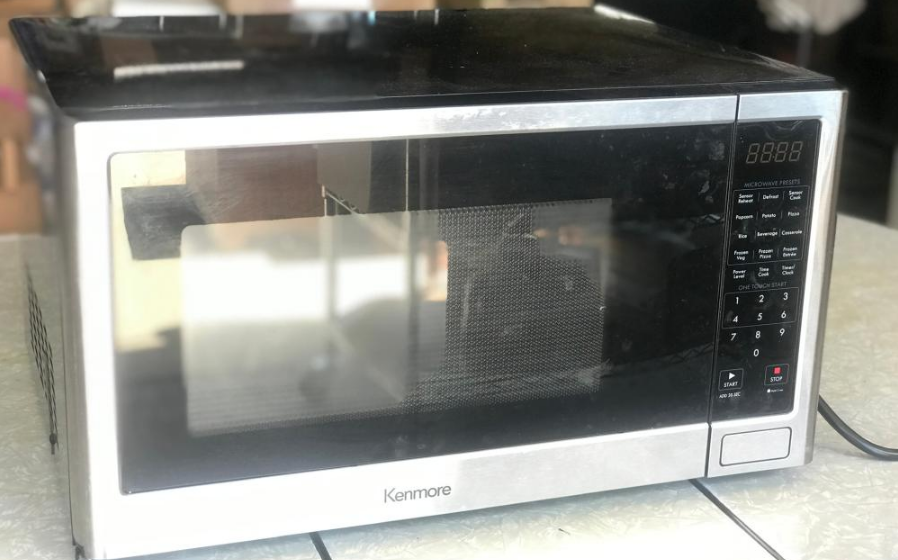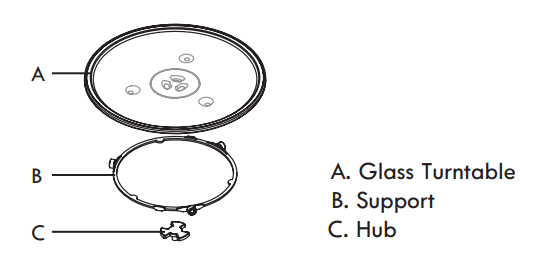
Kenmore Microwave Hood Combination
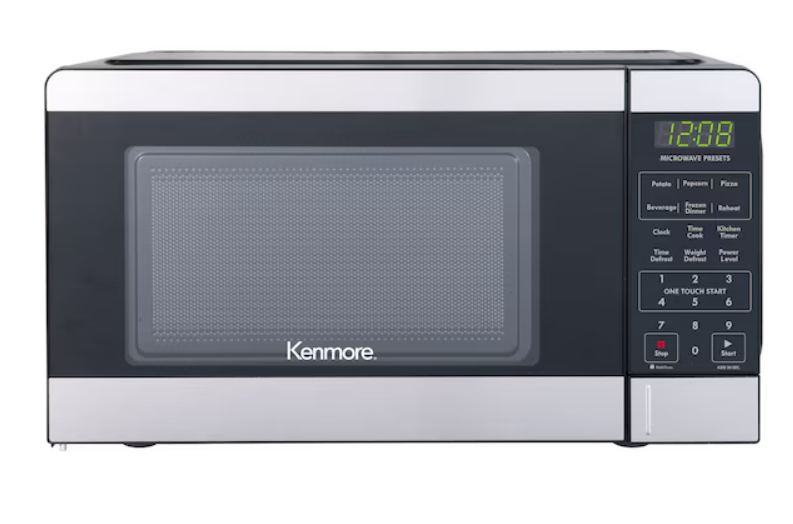
Microwave Hood Combination Warranty
Kenmore One Year Limited Warranty
When installed, operated, and maintained according to all supplied instructions, if this appliance fails due to a defect in material and workmanship within one year from the date of purchase, call 1 800-4-MY-HOME® to arrange for free repair.
This warranty applies for only 90 days from the date of purchase if this appliance is ever used for anything other than private family purposes.
This warranty covers ONLY defects in material and workmanship, and will NOT pay for:
- A service technician to instruct the user in correct product installation, operation, or maintenance.
- A service technician to clean or maintain the product.
- Expendable items that can wear out from normal use within the warranty period, including but not limited to filters, belts, light bulbs, and bags.
- Damage to or failure of the product if it is not installed, operated, or maintained according to all instructions supplied with the product.
- Damage to or failure of the product resulting from accident, abuse, misuse, or use other than its intended purpose.
- Damage to or failure of the product caused by the use of detergents, cleaners, chemicals, or utensils other than those recommended in all instructions supplied with the product.
- Damage to or failure of parts or systems resulting from unauthorized modifications made to the product.
Disclaimer of implied warranties; limitation of remedies
Customer’s sole and exclusive remedy under this limited warranty shall be product repair as provided herein. Implied warranties, including warranties of merchantability or fitness for a particular purpose, are limited to one year or the shortest period allowed by law. Sears shall not be liable for incidental or consequential damages. Some states and provinces do not allow the exclusion or limitation of incidental or consequential damages, or limitation on the duration of implied warranties of merchantability or fitness, so these exclusions or limitations may not apply to you.
This warranty applies only while this appliance is used in the United States. This warranty gives you specific legal rights, and you may also have other rights which vary from state to state.
Sears Brands Management Corporation, Hoffman Estates, IL 60179
Microwave Oven Safety
IMPORTANT SAFETY INSTRUCTIONS
When using electrical appliances, basic safety precautions should be followed, including the following:
WARNING: To reduce the risk of burns, electric shock, fire, injury to persons, or exposure to excessive microwave energy:
- Read all instructions before using the microwave oven.
- Read and follow the specific “PRECAUTIONS TO AVOID POSSIBLE EXPOSURE TO EXCESSIVE MICROWAVE ENERGY” found on page 5.
- The microwave oven must be grounded. Connect only to a properly grounded outlet. See “GROUNDING INSTRUCTIONS” found on page 5.
- Install or locate the microwave oven only according to the provided installation instructions.
- Some products, such as whole eggs in the shell and sealed containers, such as closed jars, can explode and should not be heated in the microwave oven.
- Use the microwave oven only for its intended use as described in this manual.
- Do not use corrosive chemicals or vapors in the microwave oven. This type of oven is specifically designed to heat, cook, or dry food. It is not designed for industrial or laboratory use.
- As with any appliance, close supervision is necessary when used by children.
- Do not operate the microwave oven if it has a damaged cord or plug, if it is not working properly, or if it has been damaged or dropped.
SAVE THESE INSTRUCTIONS
Getting to Know Your Microwave Oven
This section discusses the concepts behind microwave cooking. It also shows the basics that you need to know in order to operate your microwave oven. Please read this information before using your oven.
HOW YOUR MICROWAVE OVEN WORKS
Microwave ovens are safe. Microwave energy is not hot. It causes food to make its heat, and it is this heat that cooks the food. Microwaves are like TV waves, radio waves, or light waves. You cannot see them, but you can see the results of what they do.
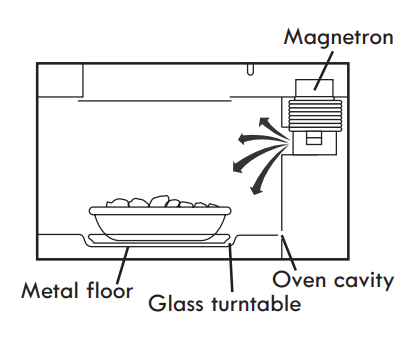
A magnetron in the microwave oven produces microwaves. The microwaves move into the oven where they contact food as it turns on the turntable.
The glass turntable of your microwave oven lets microwaves pass through the glass, then bounce off the metal floor, back through the glass turntable, and be absorbed by the food.
Microwaves pass through most glass, paper, and plastics without heating them, so food absorbs the energy. Microwaves bounce off the metal containers of food and do not absorb the energy.
RADIO INTERFERENCE
Using your microwave oven may cause interference to your radio, TV, or similar equipment. When there is interference, you can reduce it or remove it by:
- Cleaning the door and sealing the surfaces of the oven.
- Adjusting the receiving antenna of the radio or television.
- Moving the receiver away from the microwave oven.
- Plug the microwave oven into a different outlet so that the microwave oven and receiver are on different branch circuits.
FOR THE BEST COOKING RESULTS
- Always cook food for the shortest cooking time recommended. Check to see how the food is cooking. If needed, touch Add 30 Sec while the oven is operating, or after the cooking cycle is over (see the “Add 30 Sec” section).
- Stir, turn over, or rearrange the food being cooked about halfway through the cooking time for all recipes. This will help ensure that the food is evenly cooked.
- If you do not have a cover for a dish, use wax paper, microwave-approved paper towels, or plastic wrap. Remember to turn back a corner of the plastic wrap to vent steam during cooking.
- The metal shelf is used for cooking certain items and should be removed from the microwave oven when not needed. Do not store a metal shelf in the microwave oven.
COOKWARE GUIDE
Most heat-resistant, nonmetallic cookware is safe for use in your microwave oven. However, to test cookware before using, follow these steps:
- Place empty cookware in the microwave oven.
- Measure 1 cup (250ml) of water in a glass measuring cup and place it in the oven beside the cookware.
- Microwave on 100% power for 1 minute. If the cookware is warm, it should not be used for microwave cooking.
NOTE:
Some dishes (melamine, some ceramic dinnerware, etc.) absorb microwave energy, becoming too hot to handle and slowing cooking time. Cooking in metal containers, not designed for microwave use, could damage the oven, as could containers with hidden metal (twist-ties, foil lining, staples, metallic glaze or trim).
OPERATING SAFETY PRECAUTIONS
- Never lean on or allow a child to swing on the door when it is open.
- Use hot pads to handle food containers. Microwave energy does not heat containers, but the heat from the food can make the container hot.
- Do not use a newspaper or other printed paper in the oven.
- Do not dry flowers, fruit, herbs, wood, paper, gourds, or clothes in the oven.
- Do not start a microwave oven when it is empty. This may shorten the life span of the oven. To practice programming, put a container of water in the oven before starting.
- Do not try to melt paraffin wax in the oven. Paraffin wax will not melt in a microwave oven because it allows microwaves to pass through it.
- Do not operate the microwave oven unless the glass turntable is securely in place and can rotate freely. The turntable can rotate in either direction. Make sure the turntable is correct-side up in the oven. Handle your turntable with care when removing it from the oven to avoid breaking it.
- When using a browning dish, the browning dish bottom must be at least 3/16 inch above the turntable. Follow the directions supplied with the browned dish.
- Never cook or reheat a whole egg inside the shell. Steam buildup in whole eggs may cause them to burst, and possibly damage the oven. Slice hard-boiled eggs before heating. In rare cases, poached eggs have been known to explode. Cover poached eggs and allow a standing time of one minute before cutting into them.
- For best results, stir any liquid several times during heating or reheating. Liquids heated in certain containers (especially containers shaped like cylinders) may overheat. The liquid may splash during or after heating or when adding ingredients (coffee granules, tea bags, etc.). This can harm you or damage the microwave oven.
- Microwaves may not reach the center of a roast. The heat spreads from the outer to the center cooked areas, just as in regular oven cooking. This is one of the reasons for letting some foods (for example, roasts or baked potatoes) stand for a while after cooking, or for stirring some foods during the cooking time.
- Do not deep fry in the oven. Microwavable utensils are not suitable, and it is difficult to maintain appropriate deep-frying temperatures.
- Do not overcook potatoes. At the end of the recommended cooking time, potatoes should be slightly firm because they will continue cooking during standing time. After microwaving, let potatoes stand for 5 minutes. They will finish cooking while standing.
ELECTRICAL CONNECTION
If your electric power line or outlet voltage is less than 110 volts, cooking times may be longer. Have a qualified electrician check your electrical system.
SPECIFICATIONS

*IEC 60705 RATING STANDARD
Specifications subject to change without prior notification.
MICROWAVE OVEN FEATURES
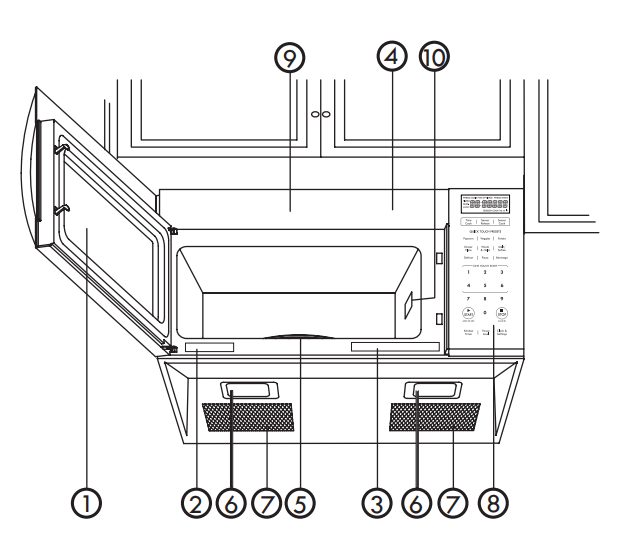
The microwave oven is designed to make your cooking experience as enjoyable and productive as possible. To get you up and running quickly, the following is a list of the oven’s basic features:
- Metal Shielded Window: The shield prevents microwaves from escaping. It is designed as a screen to allow you to view food as it cooks.
- Model and Serial Number Plate
- Cooking Guide label

- Vent Top
- Glass Turntable: The turntable reverses rotation each time the microwave oven door is opened and closed. This helps cook food evenly. Do not operate the microwave oven without the turntable in place.
To Install:- Place the support on the oven cavity bottom.
- Place the glass turntable on the support. Fit the raised, curved lines in the center of the turntable bottom between the three spokes of the hub. The rollers on the support should fit inside the turntable bottom ridge.
- Cooktop Light
- Grease Filters: See “Caring for the Filters” section.
- Control Panel: Touch the pads on this panel to perform all functions.
- Charcoal Filter: (behind Vent Top): See “Caring for the Filters” section.
- Waveguide Cover: DO NOT REMOVE.
NOTE: Not all models come with a charcoal filter.
CONTROL PANEL FEATURES
Your microwave oven control panel lets you select the desired cooking function quickly and easily. All you have to do is touch the necessary Command Pad. The following is a list of all the Command and Number Pads located on the control panel. For more information on these features, see the “Using Your Microwave Oven” section.
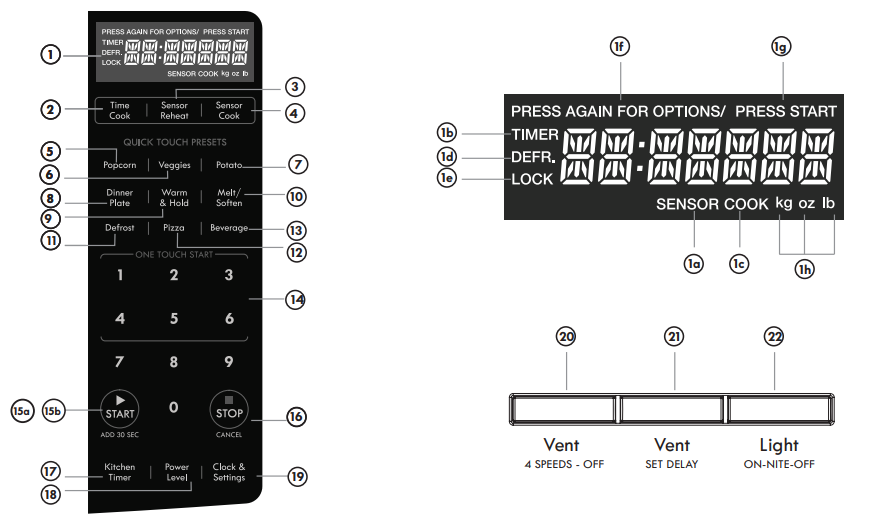
- Display: The display includes a clock and indicators that show the time of day, cooking time settings, cook powers, sensor, quantities, weight, and cooking functions selected.
- 1a. SENSOR: Icon displayed when using sensor cook.
- 1b. TIMER: Icon displayed when the timer is being set or running.
- Ic. COOK: Icon displayed when starting microwave cooking.
- 1d. DEFR: Icon displayed when defrosting food
- le. LOCK: Icon displayed in control lock.
- 1f. PRESS AGAIN FOR OPTIONS: Icon displayed when additional options are available.
- 1g PRESS START: Icon displayed when a valid function can be started.
- 1h. kg, oz, lb: Icon displayed when choosing the weight.
- Time Cook: Touch this pad, followed by the Number Pads, to set a cooking time.
- Sensor Reheat: Touch this pad to reheat microwavable foods without entering a cook time or power.
- Sensor Cook: Touch this pad to cook microwavable foods without entering a cook time or power.
- Popcorn: Touch this pad to pop one of three bag sizes of popcorn without entering a cook time or power. Remove the metal rack before cooking popcorn.
- Veggies: Touch this pad to cook fresh or frozen vegetables without entering a cook time or power.
- Potato: Touch this pad to cook up to four potatoes without entering a cook time or power.
- Dinner plate: Touch this pad to cook several servings without entering a cook time or power.
- Warm & Hold: Touch this pad to keep the food warm.
- Melt/Soften: Touch this pad to melt or soften selected items.
- Defrost: Touch this pad, followed by Number Pads, to thaw frozen meat, poultry, and fish by weight.
- Pizza: Touch this pad to reheat one to four slices of pizza without entering a cook time or power.
- Beverage: Touch this pad to heat up to 3 cup-sized beverages.
- Number Pads: Touch number pads to enter time, cook power, quantity, weight, or food category.
- 15a. START: Touch this pad to start or restart a function.
15b. Add 30 Sec.: Touch this pad to cook for 30 seconds at 100% cook power, or to add extra time to your current cooking cycle. - STOP: Touch this pad to erase an incorrect command, cancel a program during cooking, or clear the Display.
- Kitchen Timer: Touch this pad to set the kitchen timer.
- Power level: Touch this pad after the cook time has been set, followed by a Number Pad to set the amount of microwave energy released to cook the food. The higher the number, the higher the microwave power or “cooking speed.”
- Clock & Settings: Touch this pad to enter the correct time of day or set options.
- Vent 4 Speeds-off: Touch this pad to choose one of four speeds.
- Vent set Delay: Touch this pad to set the delay before the vent turns off.
- Light On/Nite/Off: Touch this pad to turn the light on high, night (low), or off.
Microwave Cooking Tips
Amount of Food
- If you increase or decrease the amount of food you prepare, the time it takes to cook that food will also change. For example, if you double a recipe, add a little more than half the original cooking time. Check for readiness and, if necessary, add more time in small increments.
Starting Temperature of Food
- The lower the temperature of the food being put into the microwave oven, the longer it takes to cook. Food at room temperature will reheat quicker than food in a refrigerator.
Composition of Food
- Food with a lot of fat and sugar will heat faster than food containing a lot of water. Fat and sugar will also reach a higher temperature than water in the cooking process.
- The more dense the food, the longer it takes to heat. “Very dense” food, like meat, takes longer to heat than lighter, more porous food, like sponge cakes.
Size and Shape
- Smaller pieces of food will cook faster than larger pieces. Also, the same shape pucks aly and differently shaped pieces.
- With foods that have different thicknesses, the thinner parts will cook faster than the thicker parts. Place the thinner parts of the chicken wings and legs in the center of the dish.
Stirring and Turning Foods
- Stirring and turning foods spreads heat quickly to the center of the dish and avoids overcooking at the outer edges of the food.
Covering Food
- Cover food to reduce splattering, shorten cooking times, and keep food moist.
You can use any covering that lets microwaves pass through. See “Getting to Know Your Microwave Oven” for materials that microwaves will pass through.
Releasing Pressure in Foods
- Several foods (for example, baked potatoes, sausages, egg yolks, and some fruits) are tightly covered by a skin or membrane. Steam can build up under the membrane during cooking, causing the food to burst. To relieve the pressure and to prevent bursting, pierce these foods before cooking with a fork, cocktail pick, or toothpick.
Using Standing Time
- Always allow food to stand, either in or out of the oven, after the cooking power stops. Standing time after defrosting and cooking allows the temperature to evenly spread throughout the food, improving the cooking results. For inside oven standing time, you can program a “0” power second stage of the cooking cycle. See Two-Stage Cooking.
- The length of the standing time depends on how much food you are cooking and how dense it is. Sometimes it can be as short as the time it takes to remove the food from the oven and take it to the serving table. However, with a larger, denser food item, the standing time may be as long as 10 minutes.
Arranging Food
For best results, place food evenly on the plate. You can do this in several ways:
- If you are cooking several items of the same food, such as baked potatoes, place them in a ring pattern for uniform cooking.
- When cooking foods of uneven shapes or thickness, such as chicken breasts, place the smaller or thinner area of the food towards the center of the dish, where it will be heated last.
- Layer thin slices of meat on top of each other.
- When you cook or reheat whole fish, score the skin – this prevents cracking.
- Do not let food or a container touch the top or sides of the oven. This will prevent possible arcing. Arcing is a spark that can cause damage to the oven interior.
Using Aluminum Foil
NOTE: Metal containers should not be used in a microwave oven. There are, however, some exceptions. If you have purchased food prepackaged in an aluminum foil container, refer to the instructions on the package. When using aluminum foil containers, cooking times may be longer because microwaves will only penetrate the top of the food. When using aluminum containers without package instructions, follow these guidelines:
- Place the container in a glass bowl and add some water so that it covers the bottom of the container more than 1/4 in. (.60 cm). This ensures even heating of the container bottom.
- Always remove the lid to avoid damage to the oven.
- Use only undamaged containers.
- Do not use containers taller than 3/4 in. (1.9 cm).
- The container must be at least half filled.
- To avoid arcing, there must be a minimum of 1/4 in. (.60 cm) between the aluminum container and the walls of the oven and also between two aluminum containers.
- Always place the container on the turntable.
- Shield, with small pieces of aluminum foil, parts of food that may cook quickly, such as wing tips and leg ends of poultry.
- Heating food in aluminum foil containers usually takes up to double the time compared to reheating in plastic, glass, china, or paper containers. The time when food is ready will vary depending on the type of container used.
- Let food stand for 2 to 3 minutes after heating so that the heat is spread evenly throughout the container.
Cooking you should not do in your microwave oven..
- Do not put canned foods in the oven. Closed glass jars may explode, resulting in damage to the oven.
- Do not use the microwave oven to sterilize objects (baby bottles, etc.). It is difficult to keep the oven at the high temperature needed for sterilization.
Using Your Microwave Oven
This section gives instructions for operating each function. Please read this section carefully.
CLOCK & SETTINGS (Control Panel Feature 19)
The microwave oven has settings that allow you to customize the operation for your convenience. Below is the table showing the various settings. Touch the Clock & Settings key multiple times to scroll to the desired setting function.
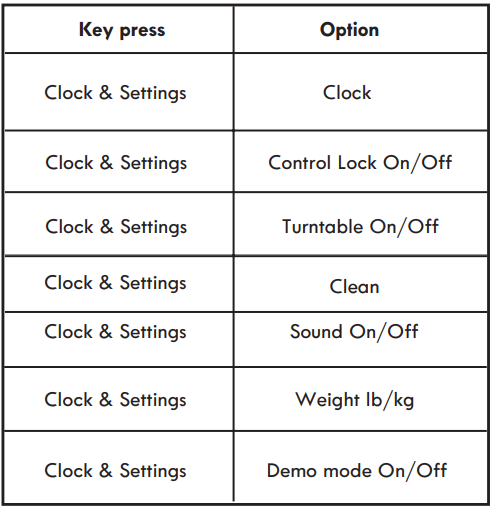
SETTING CLOCK (Control Panel Feature 19)
The clock can be disabled when the microwave is first plugged in and the STOP key is selected. To re-enable the clock, follow the clock instructions.
Example: To set the clock for 10:59.
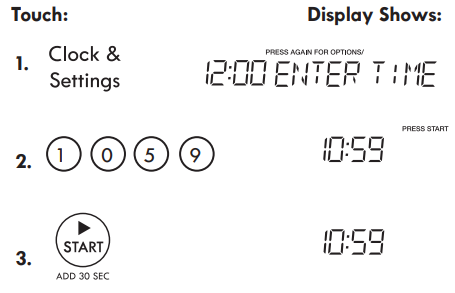
NOTE:
- If you begin to enter an incorrect time (e.,2:89), the 8 is an invalid digit and cannot be entered. Enter the correct time.
- If you touch STOP while setting the clock, the display will show the last time of day set or a blank display if no time of day has been set.
Troubleshooting
Most cooking problems are often caused by little things that you can find and fix without tools of any kind. Check the lists below and on the next page before calling for assistance or service. If you still need help, call Sears Service at 1-800-4-MY-HOME.
MICROWAVE OVEN DOES NOT WORK
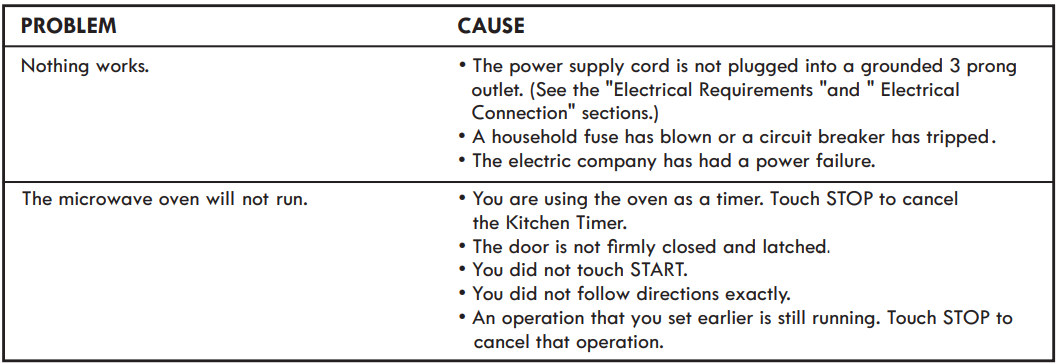
COOKING TIMES

TURNTABLE

TONES

For more manuals by Kenmore, visit ManualsLibraryy
Kenmore Microwave Hood Combination- FAQs
Where is the fuse located on a Kenmore microwave hood combo?
The fuse is found under the top plastic grill, which is secured with two screws. After removing the grill, check the right side of the microwave behind a small metal cover held by another screw.
What is the size of the Kenmore Microwave Model 721?
The Kenmore 721 model has a capacity of 1.9 cubic feet and fits in a 30-inch wide space.
How do I read Kenmore model numbers?
Kenmore model numbers begin with a three-digit prefix followed by a dot and a series of numbers. The prefix helps identify the manufacturer of the appliance.
Why did my Kenmore microwave stop working?
Common causes include a faulty control board, defective thermostat, or a broken switch. These components may need repair or replacement.
Who manufactures Kenmore microwaves?
Kenmore appliances are made by various manufacturers, including Whirlpool, LG, Panasonic, and Daewoo Electronics, among others.
How many watts does a Kenmore microwave use?
Most Kenmore microwaves operate at 900 watts and come with features like auto-cook menus, defrost options, and a child safety lock.
How much ventilation space does a microwave need?
Ensure at least 1 inch of space behind the microwave, 3 inches from the counter edge to the open door, and 2 feet between the microwave and any range below for proper ventilation and safety.
How can I find the model number on my Kenmore microwave?
Look for a sticker or metal plate on the appliance—usually inside the door frame or back panel—displaying the model number.
What size microwave is right for me?
Microwave sizes range from 25L to 50L. For basic tasks like reheating, a smaller size is fine. For cooking full meals or serving a large family, opt for a larger model.

